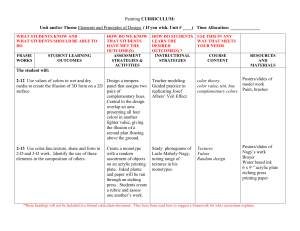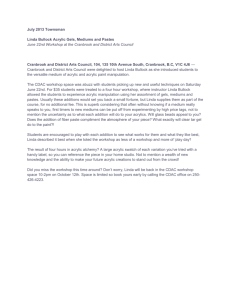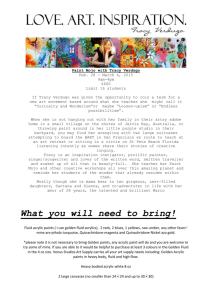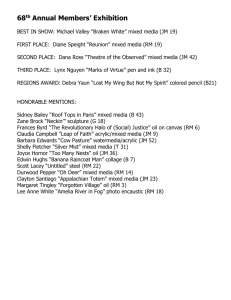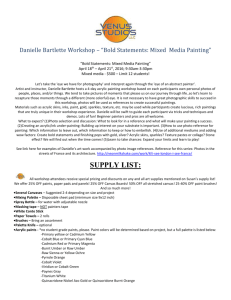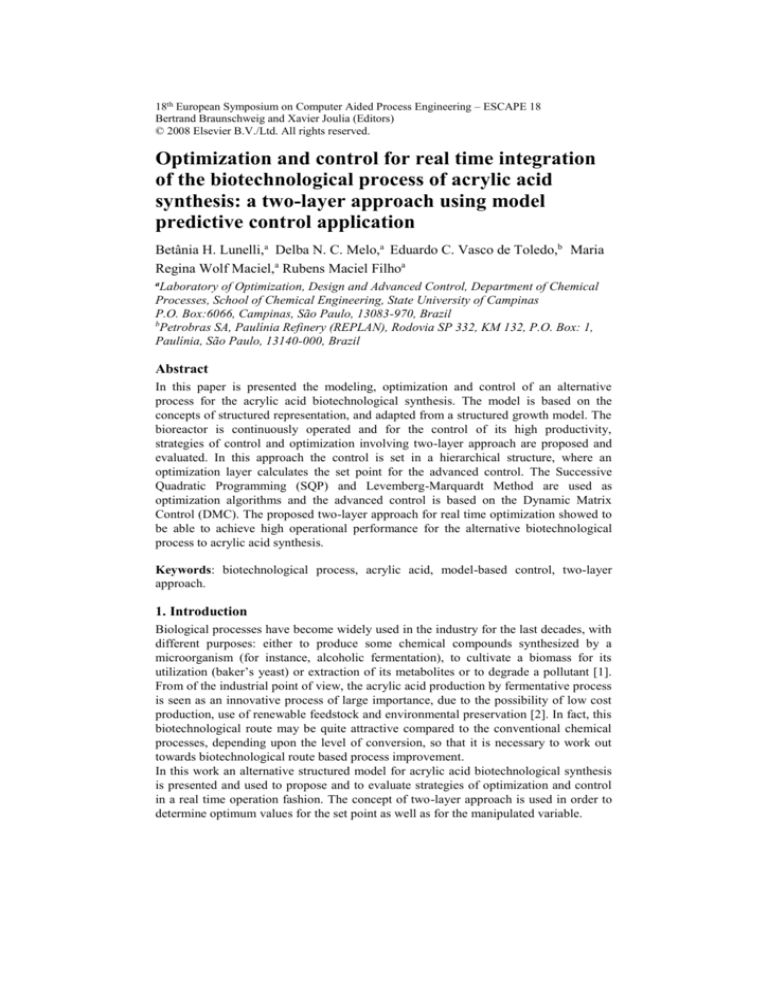
18th European Symposium on Computer Aided Process Engineering – ESCAPE 18
Bertrand Braunschweig and Xavier Joulia (Editors)
© 2008 Elsevier B.V./Ltd. All rights reserved.
Optimization and control for real time integration
of the biotechnological process of acrylic acid
synthesis: a two-layer approach using model
predictive control application
Betânia H. Lunelli,a Delba N. C. Melo,a Eduardo C. Vasco de Toledo,b Maria
Regina Wolf Maciel,a Rubens Maciel Filhoa
a
Laboratory of Optimization, Design and Advanced Control, Department of Chemical
Processes, School of Chemical Engineering, State University of Campinas
P.O. Box:6066, Campinas, São Paulo, 13083-970, Brazil
b
Petrobras SA, Paulínia Refinery (REPLAN), Rodovia SP 332, KM 132, P.O. Box: 1,
Paulínia, São Paulo, 13140-000, Brazil
Abstract
In this paper is presented the modeling, optimization and control of an alternative
process for the acrylic acid biotechnological synthesis. The model is based on the
concepts of structured representation, and adapted from a structured growth model. The
bioreactor is continuously operated and for the control of its high productivity,
strategies of control and optimization involving two-layer approach are proposed and
evaluated. In this approach the control is set in a hierarchical structure, where an
optimization layer calculates the set point for the advanced control. The Successive
Quadratic Programming (SQP) and Levemberg-Marquardt Method are used as
optimization algorithms and the advanced control is based on the Dynamic Matrix
Control (DMC). The proposed two-layer approach for real time optimization showed to
be able to achieve high operational performance for the alternative biotechnological
process to acrylic acid synthesis.
Keywords: biotechnological process, acrylic acid, model-based control, two-layer
approach.
1. Introduction
Biological processes have become widely used in the industry for the last decades, with
different purposes: either to produce some chemical compounds synthesized by a
microorganism (for instance, alcoholic fermentation), to cultivate a biomass for its
utilization (baker’s yeast) or extraction of its metabolites or to degrade a pollutant [1].
From of the industrial point of view, the acrylic acid production by fermentative process
is seen as an innovative process of large importance, due to the possibility of low cost
production, use of renewable feedstock and environmental preservation [2]. In fact, this
biotechnological route may be quite attractive compared to the conventional chemical
processes, depending upon the level of conversion, so that it is necessary to work out
towards biotechnological route based process improvement.
In this work an alternative structured model for acrylic acid biotechnological synthesis
is presented and used to propose and to evaluate strategies of optimization and control
in a real time operation fashion. The concept of two-layer approach is used in order to
determine optimum values for the set point as well as for the manipulated variable.
2
B. H. Lunelli et al
2. Structured Mathematical Model
A structured mathematical model for simulating the biotechnological synthesis of
acrylic acid was developed. In this approach is possible to obtain acrylic acid
continuously from the sugar cane fermentation [3]. The model was adapted from a
structured growth model developed by Lei et al. [4] and modified to simulate the
intrinsic reactions taking place in the fermentation process to obtain acrylic acid.
A continuous stirred tank bioreactor (CSTBR) was used in the modeling. The bioreactor
behavior is based on the mass balances for the main components of the fermentative
process and a kinetic predictive, based on Michaelis-Menten kinetic was established for
the process. The mass balance equations of the model can be described of the following
form:
S
R1 R2 X DS in S
t
P
0.978 R1 R3 X DP
t
L
1.023 R3 R4 R5 X DL
t
AA
0.8R4 X D AA
t
X
0.732 R2 0.821R5 X D X in X
t
X a
0.732 R2 0.821R5 R6 R7 0.732 R2 0.821R5 X a
t
X Ladh
R6 0.732R2 0.821R5 X Ladh
t
(1)
(2)
(3)
(4)
(5)
(6)
(7)
where, S is the substrate concentration; Ri is the reaction rate; D is the dilution rate; P is
the pyruvate concentration; X is the biomass concentration; L is the lactate
concentration; AA is the acrylic acid concentration; Xa is the active cell material; XLadh
is the lactate dehydrogenase enzyme.
The model was developed in FORTRAN language and the system of ordinary
differential equations was integrated, in respect to time, by LSODAR integrator.
3. Process control
3.1. Two-layer approach
The control of bioreactors is a delicate problem since most of the time the available
biological models are only rough approximations [1]. When high operational
performance is required is necessary to be able to define optimal or near optimal
operating conditions in a continuous basis. To control and to optimize the continuous
bioreactor of acrylic acid synthesis is proposed the implementation of the two-layer
strategy. In this strategy, the control is set in a hierarchical structure, where an
optimization layer calculates the set point to the advanced control. Fig. 1 represents
Optimization and control for real time integration of the biotechnological process of
acrylic acid synthesis: a two-layer approach using model predictive control application 3
schematically the two-layer real time optimization (RTO) strategy. This strategy is
usually more reliable and less sensitive to model mismatch when compared to other
RTO approaches. The lower layer is responsible for the process control, and the upper
layer, determines, through the optimization algorithms, the best set point of the variable
for steady state, as function of the controlled variable, process constraints and of the
objective function. This information is sent to the lower layer as a set point of the
controlled variable [5]. The optimization algorithm is based on the either Successive
Quadratic Programming (SQP) or Levenberg-Marquardt Method, which solve a nonlinear least square problem subject constrains in the manipulated variable. The
advanced control is based on the Dynamic Matrix Control (DMC). Details regarding the
Successive Quadratic Programming (SQP), Levenberg-Marquardt Method and Dynamic
Matrix Control can be found in Biegler and Grossman [6], Marquardt [7] and Luyben
[8], respectively.
O P T IM IZ E R
- stead y -state m o d el
- o b jectiv e fu n ctio n
- algo rith m o p tim izatio n
set p o int
CONT ROLLER
- co n v o lu tio n m o d el
- o b jectiv e fu n ctio n
- algo rith m N L P
Id en tificatio n b lo ck
measured inp uts
no n- measured
inp uts
P RO CESS
measured o utp uts
- d y n am ic m o d el
no n- measured
o utp uts
Figure 1. Schematic of the two-layer approach for real time integration [5]
This control structure supported by an optimization layer in the two-layer approach is
very important to guarantee a safe and effective operation of the reactor when
meaningful changes occur in the reactor operational conditions. Also, it is worthwhile
mentioning that the optimized value of the set point and manipulated variable may be
either directly implemented or used in a piecewise form, depending on the process
sensitivity or safety procedure [5].
In this work, the optimization was carried out with the process deterministic model; in
fact, the mass balances for the continuous bioreactor (Eqs. 1-7). The main goal of the
optimization is to maximize the acrylic acid yield. The problem is subject to the equality
constraint described by the mass balances and to the inequality constrains. The yield can
be described by:
Y AA
S
AA
S in S
(8)
where, AA is the acrylic acid concentration, Sin and S are the feed substrate
concentration and substrate concentration at the exit of the reactor, respectively.
4
B. H. Lunelli et al
Therefore, the objective function was formulated as follows:
Max f x
s.t. Eqs. 1 7 steady state
0.01 D 0.5
(9)
where, f x yield and D (dilution rate) is the optimized variable. Through the
dilution rate optimization it is possible to maximize also the yield of intermediates
products (pyruvate and lactate) and to analyze their influence on the acrylic acid final
concentration. In the two-layer approach, it was proposed two strategies of optimization
and control. In the first, the feedback strategy, the optimum value of the controlled
variable (acrylic acid final concentration) is calculated in the optimization layer and
then sent to the advanced control (DMC), as set point. In this strategy, at each time
interval, a new value of the manipulated variable (D) is calculated with the purpose of
leading the process to reach the optimum set point. In the second strategy the feedback
plus feedforward strategy is implemented. In this strategy the optimized controlled (set
point) and optimized manipulated variables are sent to the controller and the process is
operated in the optimum conditions from the start of the process. An alternative
procedure the manipulated variable may or not be used directly in the process
(feedforward strategy).
4. Results and discussion
A two-layer approach was proposed and applied to evaluate its benefits on the
alternative process proposed for the acrylic acid production. The bioreactor is fed
continuously with a substrate concentration (Sin), a biomass concentration (Xin) and a
dilution rate (D) of 0.05h-1, and a structured model represents its kinetics. The Fig. 2
depicts the concentration profiles of the main process components of acrylic acid
production, obtained by the simulation of the developed model.
Concentration (kg m
-3
)
70
60
50
40
30
Substrate
Pyruvate
Lactate
Acrylic acid
Biomass
20
10
0
0
10
20
30
Time (h)
40
50
Figure 2. Concentration profiles of the main process components
Through the open-loop simulations, it was possible to identify the influence of the
operational parameters on the acrylic acid concentration at the bioreactor. From
obtained open-loop results, it was identified that the dilution rate is the most influent
process variable; therefore, this variable was used as manipulated variable. Acrylic acid
final concentration in the reactor exit was used as controlled variable (set point). As the
kinetic of the biotechnological process of acrylic acid synthesis is a predictive kinetics,
all parameters used in the model were simulated and can be changed by the user
Optimization and control for real time integration of the biotechnological process of
acrylic acid synthesis: a two-layer approach using model predictive control application 5
together with the operating and design conditions. This makes this tool a very
interesting one to study and to search operating conditions, which leads to yield as
closer as possible, of the stoichiometric yield. Initially, it was optimized the
manipulated variable (dilution rate), with the purpose of founding an optimum value to
maximize the acrylic acid yield. Posteriorly, it was seen that is interesting to maximize
the yield of the intermediates products. In such study, it was possible to realize that the
optimized value of the manipulated variable to maximize the intermediates products is
different of the optimum value to maximize the acrylic acid concentration. These results
are show in Table 1. This is an important feature to be understood in the definition of
the operation and control strategies, since the intermediates products can be on-line
monitored a long the process running time.
Table 1. Optimum value of manipulated variable
Product
Optimum value of the dilution rate (D) (in 50 hours of process)
Acrylic acid
0.0864
Pyruvate
0.5000
Lactate
0.0794
The Successive Quadratic Programming and Levenberg-Marquardt optimization
algorithms were used in the real time process integration through two-layer approach.
The SQP requires a higher number of iterations to found out the manipulated variable,
providing a pathway of the optimal conditions, while the Levenberg-Marquardt method
generates only the optimum value. The optimum value obtained for manipulated
variable by two methods of optimization was identical, leading thus to the same results
for acrylic acid concentration. However in some cases is important to know the root
locus of possible optimal values to take decisions, especially the economic ones. The
Fig. 3 shows the yields of acrylic acid obtained with different values of the manipulated
variable by the application of the SQP algorithms.
Figure 3. Two-layer approach: acrylic acid yield
The Fig. 4 shows the performance two-layer approach; where the main objective it was
maximizes the acrylic acid yield in the bioreactor exit. In the feedback strategy, when
the optimized manipulated variable is not used in the process, and only the set point is
sent the response is slower. When feedback plus feedforward strategy was applied the
optimized manipulated variable is used and set point calculated is sent to controller and
a quicker response is obtained, considering fast and robust performance for this strategy
when compared with feedback strategy. It was possible also to obtain a yield near of
6
B. H. Lunelli et al
-3
80
70
60
50
40
30
20
10
0
Feedback
Feedback-Feedforward
Open-loop
Optimum set point
0
10
20
30
Time (h)
40
50
Figure 4. Two-layer approach: acrylic acid
concentration profiles
Acrylic acid concentration (kg m
Acrylic acid concentration (kg m
-3
)
)
stoichiometric yield (0.8). In Fig. 5, it is possible to visualize the acrylic acid
concentration in the bioreactor exit, when the manipulated variable was optimized to
maximize the acrylic acid yield and also the yield of the intermediate products (pyruvate
and lactate). In these simulations the feedback plus feedforward strategy was used.
72
64
56
48
40
32
24
16
8
0
Doptimumpyruvate
Doptimumlactate
Doptimumacrylic acid
0
10
20
Time (h)
30
40
Figure 5. Two-layer approach: acrylic acid
concentration profiles
These results showed the potential of the two-layer approach based on SQP and
Levenberg-Marquardt methods of optimization and advanced control to achieve high
operational performance for the alternative biotechnological process to acrylic acid
synthesis.
5. Conclusion
In this work was proposed and evaluated a two-layer optimization strategy for an
alternative process for acrylic acid synthesis. Through of the application of this strategy
it was possible to determine the best value of manipulated variable (D) to maximize the
acrylic acid concentration and also to determine the maximum concentration that can be
obtained for this proposed process. Evaluation of optimization studies to is necessary to
identify the high sensitive of some parameters in the process operational performance.
This information is important in the definition of working control strategies in the twolayer approach context aiming lower operating and production costs.
Acknowledgments
The authors are thankful to FAPESP for the financial support.
References
[1] L. Mailleret, O. Bernard and J. P. Steyer, Automatica, 40 (2004) 1379-1385.
[2] B. H. Lunelli, E. R. Duarte, E. C. Vasco de Toledo, M. R. Wolf-Maciel and R. Maciel Filho,
Appl. Biochem. Biotechnol., 138 (2007) 487-499.
[3] B. H. Lunelli, Modeling and control of the acrylic acid synthesis by fermentative process.
FAPESP Report, August 16, São Paulo, Brazil, 2007. (in Portuguese)
[4] F. Lei, M. Rotboll and S. B. Jorgensen, J. Biotechnol., 88 (2001) 205-211.
[5] D. N. C. Melo, E. C. Vasco de Toledo, M. M. Santos, S. D. M. Hasan, M. R. Wolf-Maciel and
R. Maciel Filho, Comput. Chem. Eng., 29 (2005) 2485-2493.
[6] L. Biegler and I. E. Grossmann, Comput. Chem. Eng., 28 (2004) 1169-1192.
[7] D. W. Marquardt, J. Soc. Ind. Appl. Math., 11 (1963) 431-441.
[8]W. L. Luyben, Process modeling simulation and control for chemical engineers. 2n ed.
McGraw-Hill Publishing Company, New York, 1996.



